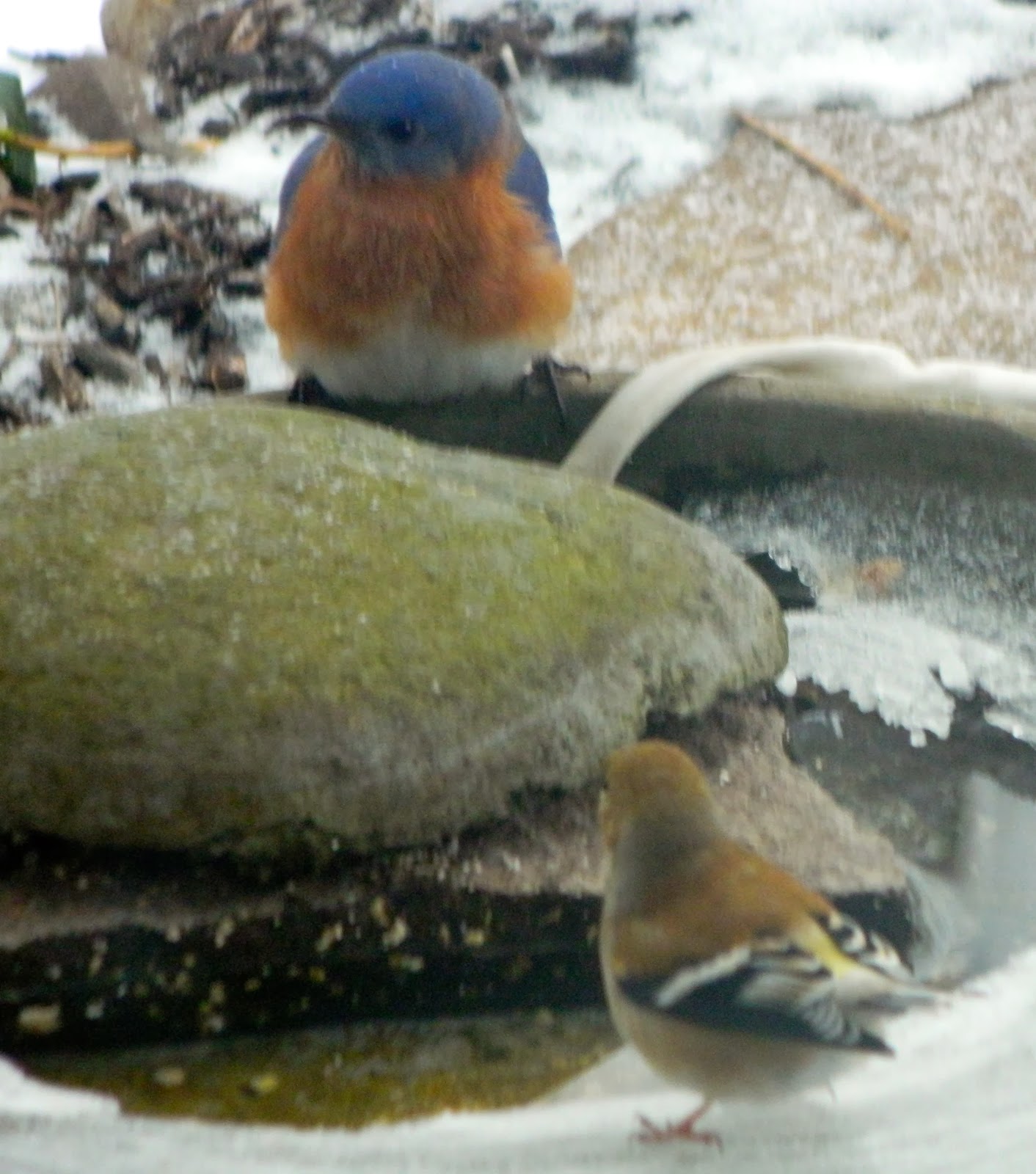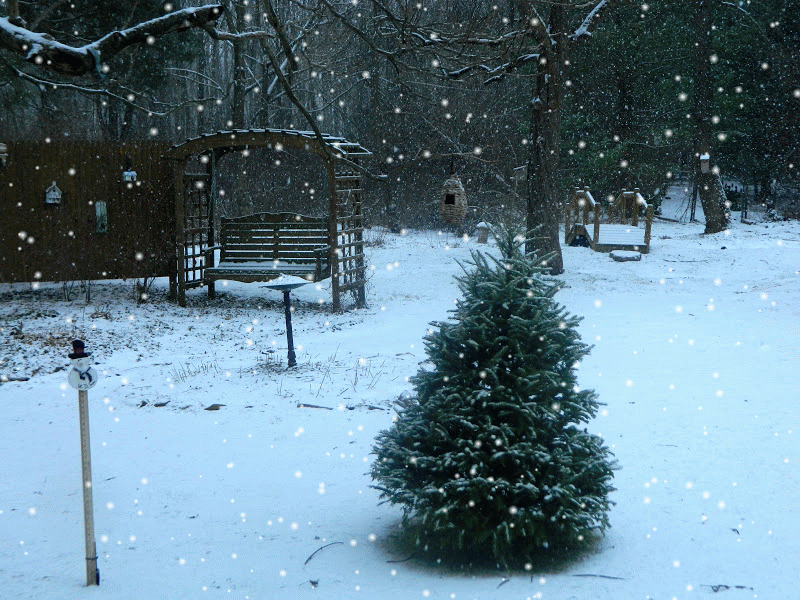The 17th annual
Great Backyard Bird Count begins on Friday, February 14 and continues through Monday. I'm ready, are you? The count is important, helping scientists track the abundance, distribution, and movements of birds around the world. It is a joint project of the Cornell Lab. of Ornithology and the National Audubon Society, with Canadian partner Bird Studies Canada. Anyone can participate and it is so easy ... just count birds for at least 15 minutes on one or more days. I do this while sitting in my favorite chair in the garden room and watching through the glass of the French doors which provides a clear view across the back porch to the shade garden. H.H. has placed bird feeders and a water dish in my line of vision.
If you haven't participated before, but would like to advance the understanding and protection of birds, it is easy to get started. First, register on the GBBC site. There is a link in my blog sidebar and another in the first sentence of this posting. Or click on '
register for the count' here. You can count for longer than 15 minutes if you wish!
'Count birds in as many
places and on as many days as you like—one day, two days, or all four
days. Submit a separate checklist for each new day, for each new
location, or for the same location if you counted at a different time of
day.' Enter the results on the GBBC website, or download the free app and enter on your mobile device. There is also the option of mailing in a pdf data form.
If you hesitate to join in because you feel you don't know all the bird names, there is bird ID help on the website, including some neat birding apps. It is a wonderful opportunity to get to know your feathered friends.
H.H. began preparing for the count by providing food, water, and shelter for birds within my view...
FOOD
We purchased a new bird feeder because squirrels figured out how to get into the old one. The new one has a tube to contain seeds and is surrounded by a decorative metal cage. Birds land on metal perches and feed from open ports. If a squirrel puts its weight on a perch, the metal cage goes down to cover the ports. The perches spring back up and the ports open when the squirrel removes itself.
 |
| A house finch was the first bird to try the new feeder. |
We've tried various 'squirrel-proof' bird feeders, but this is the first of its kind. I will be interested to see how well it works, as we haven't yet found anything totally squirrel proof.
 |
| So far the squirrels are content with seed that has fallen on the snow below. |
 |
| A nuthatch samples the new feeder. |
 |
| The cardinal prefers to feed on the ground. |
We also have a small, open feeding-dish on the porch. Squirrels can't reach this small dish as it is high up on the wall. It's a favorite spot for nuthatches, titmice, and chickadees.
 |
| A titmouse goes to his favorite eating spot on the back porch. |
In addition to seed, H.H. provides suet for the woodpeckers. Again, we use a squirrel-proof container.
WATER
A 'must' for winter birds is a heated water dish. Ours is on the porch near the bird feeder.
 |
| Bluebirds love the heated water dish. |
 |
| A bluebird and a goldfinch chat at the water dish (well, I like to think they are chatting.) |
SHELTER
Birds need a place to shelter while they wait their turn to go to feeders and water dishes. Sometimes they sit on a branch in the catalpa tree where the feeder hangs. As an extra spot for shelter, H.H. placed the used Christmas tree nearby. He does this every year after I have removed the decorations. The birds love it. Usually, I string peanuts across the branches and add pine cones covered in peanut butter. I wasn't able to do it this year because of illness, but the tree still makes a useful contribution to the comfort of winter birds.
 |
| Used Christmas tree. |
 |
| A dark-eyed junco shelters under the used Christmas tree. |
Armed with binoculars, a notepad and pen, and my iPad, I am indeed ready. Oh, and I keep my camera to hand also. There is a photo contest as part of the GBBC, but I never considered any of my pics. good enough to enter. It's fun, however, browsing through the photographs that are submitted. Maybe I will have-a-go this year.
Hope is the thing with feathers (254)
by
Emily Dickinson
Hope is the thing with feathers
That perches in the soul,
And sings the tune without the words,
And never stops at all,
And sweetest in the gale is heard;
And sore must be the storm
That could abash the little bird
That kept so many warm.
- See more at: http://www.poets.org/viewmedia.php/prmMID/19729#sthash.1aYpJO3H.dpuf
Hope is the thing with feathers
That perches in the soul,
And sings the tune without the words,
And never stops at all,
And sweetest in the gale is heard;
And sore must be the storm
That could abash the little bird
That kept so many warm.
–from "
Hope is the thing with feathers" by
Emily Dickinson - See more at: http://www.poets.org/viewmedia.php/prmMID/20947#sthash.J9migmBJ.dpuf
Hope is the thing with feathers
That perches in the soul,
And sings the tune without the words,
And never stops at all,
And sweetest in the gale is heard;
And sore must be the storm
That could abash the little bird
That kept so many warm.
–from "
Hope is the thing with feathers" by
Emily Dickinson - See more at: http://www.poets.org/viewmedia.php/prmMID/20947#sthash.J9migmBJ.dpuf
Hope is the thing with feathers
That perches in the soul,
And sings the tune without the words,
And never stops at all,
And sweetest in the gale is heard;
And sore must be the storm
That could abash the little bird
That kept so many warm.
–from "
Hope is the thing with feathers" by
Emily Dickinson - See more at: http://www.poets.org/viewmedia.php/prmMID/20947#sthash.J9migmBJ.dpuf
Hope is the thing with feathers
That perches in the soul,
And sings the tune without the words,
And never stops at all,
And sweetest in the gale is heard;
And sore must be the storm
That could abash the little bird
That kept so many warm.
–from "
Hope is the thing with feathers" by
Emily Dickinson - See more at: http://www.poets.org/viewmedia.php/prmMID/20947#sthash.J9migmBJ.dpuf
Hope is the thing with feathers
That perches in the soul,
And sings the tune without the words,
And never stops at all,
And sweetest in the gale is heard;
And sore must be the storm
That could abash the little bird
That kept so many warm.
–from "
Hope is the thing with feathers" by
Emily Dickinson - See more at: http://www.poets.org/viewmedia.php/prmMID/20947#sthash.YgrXxe0u.dpuf
Hope is the thing with feathers
That perches in the soul,
And sings the tune without the words,
And never stops at all,
And sweetest in the gale is heard;
And sore must be the storm
That could abash the little bird
That kept so many warm.
–from "
Hope is the thing with feathers" by
Emily Dickinson - See more at: http://www.poets.org/viewmedia.php/prmMID/20947#sthash.YgrXxe0u.dpuf
I apologize, dear gardening friends, for not posting lately or visiting your blogs, but I was in the hospital. I am usually a very private person, but I feel I have so many wonderful friends among garden bloggers around the world, that I can share this problem, as many of you were 'there' for me when I had heart surgery, three years ago. This time I had a very painful gastritis since September and my stomach would not heal. I lost 30 pounds because I couldn't eat, so my wonderful doctors decided it was necessary to remove the offending part of the stomach. The partial gastrectomy was a much bigger operation than I expected, and recovery is somewhat slow, but they tell me I will return to full health for the start of the gardening season!!! (I worked that well, didn't I?) They haven't found the cause, and more tests are necessary, even after numerous biopsies. But one thing we know -- there is NO cancer - my worst fear. I am a firm believer in the power of prayer and thank everyone who sent prayers and good wishes my way!
Another big snow storm is heading here from the Southeast where it is hitting hard as I write ... there are hundreds of thousands without electricity. Hopefully, we wont get it so bad, and have a respite this weekend, so we can enjoy the birds.
I'll end with a little haiku:
A bird in winter
With blanket of its feathers
Venturing nature
-- Jyoti Chaudhary
Such brave little birds -- I will not venture out in this awful weather.
Love,
Pamela x
 |
| It is snowing again. |
~~ I love reading your comments. I hope you leave one so I’ll know you visited!
I look forward to visiting your blog in return.



















